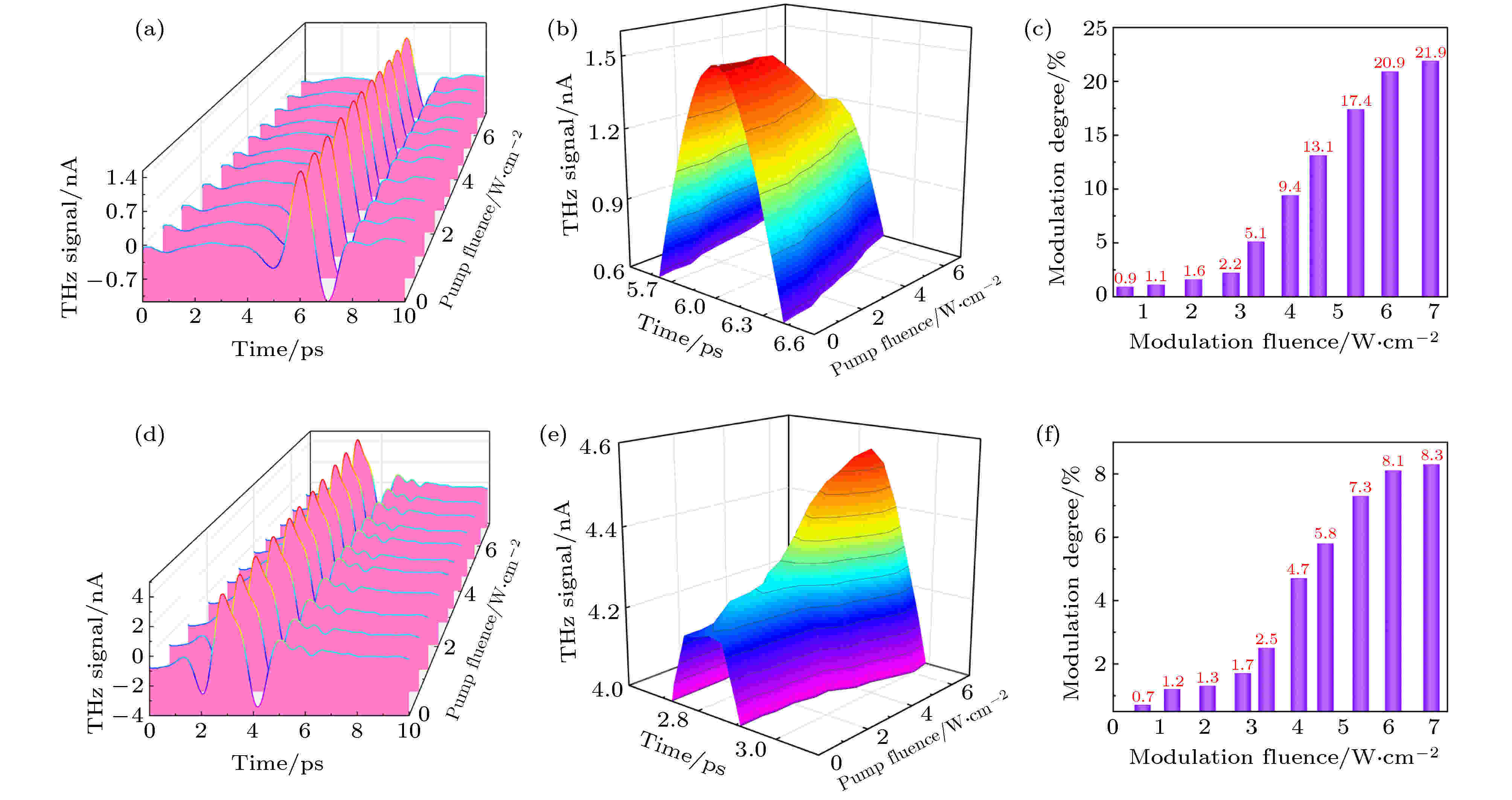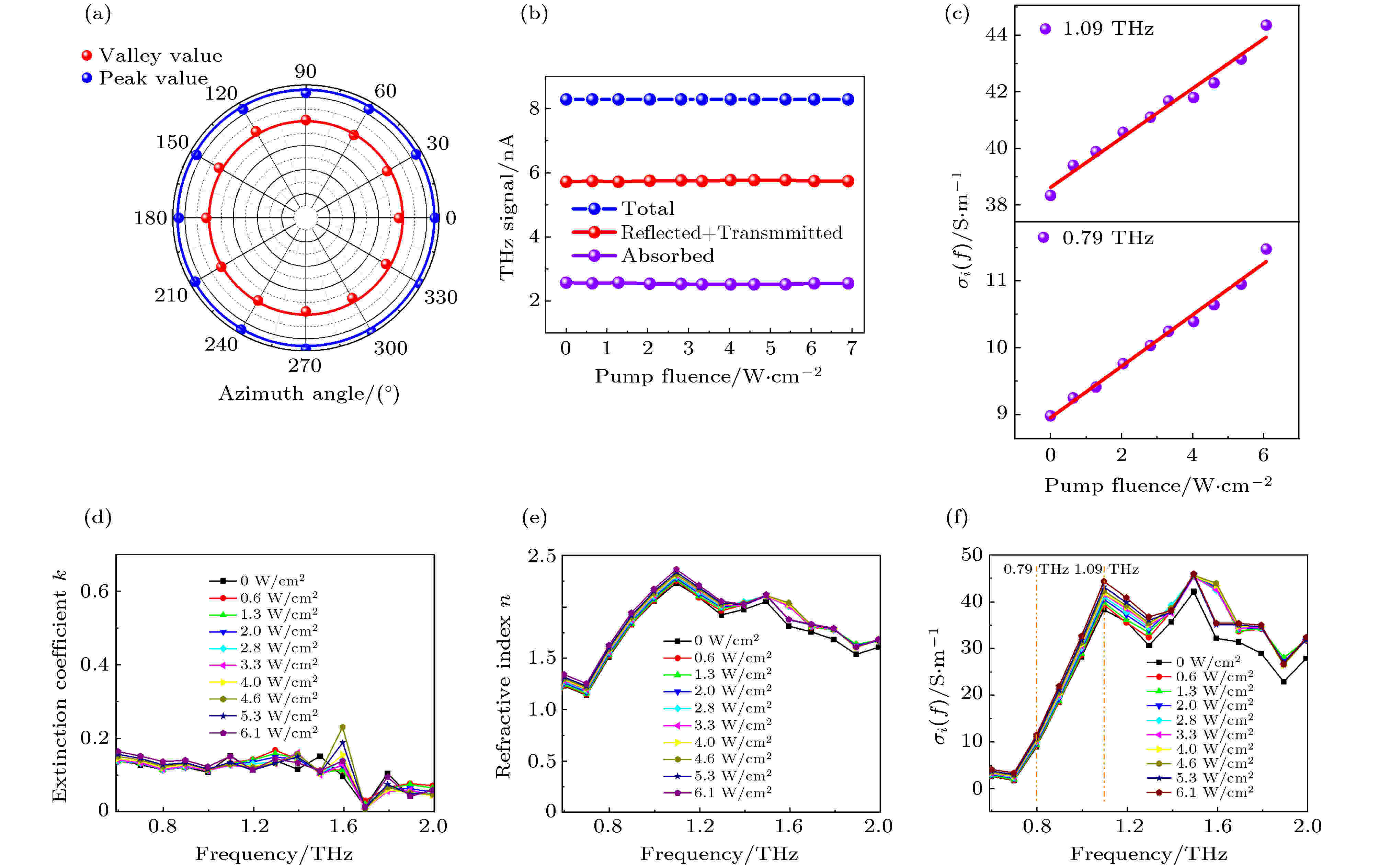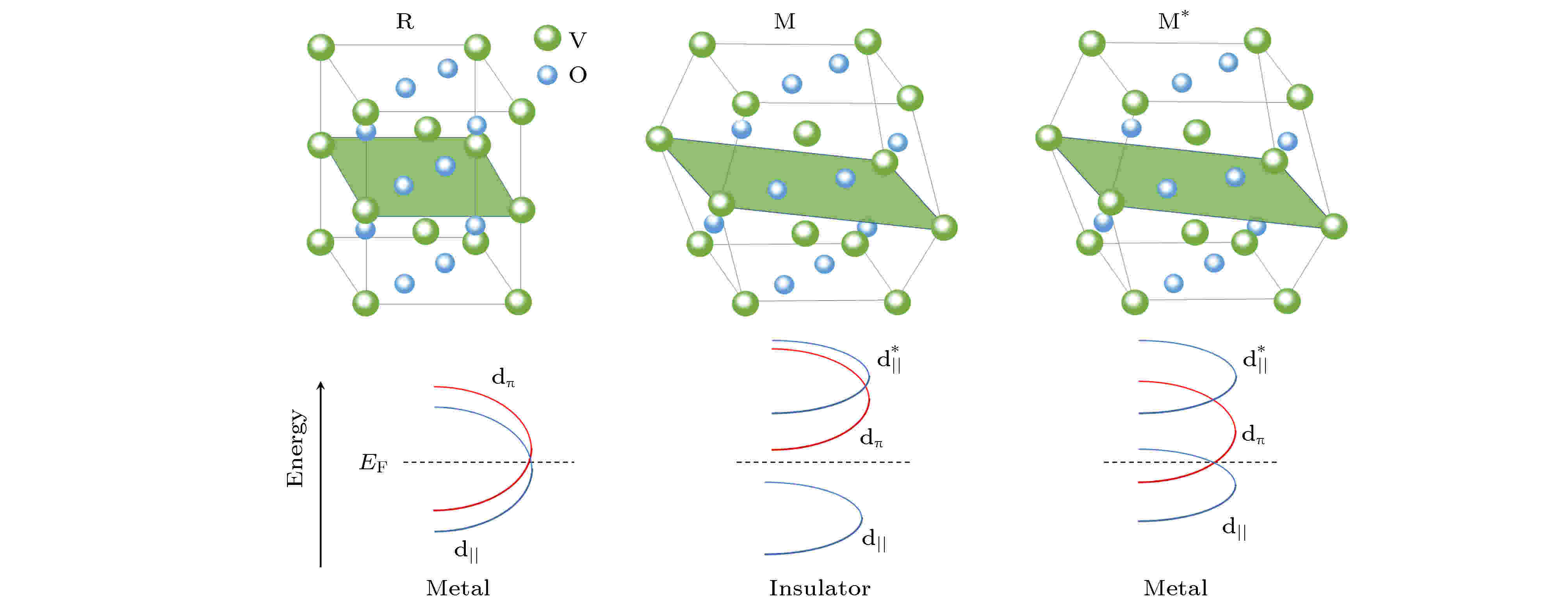全文HTML
--> --> -->自从1959年二氧化钒的相变开关特性被发现以来[16], 其一直作为典型的金属-绝缘体转变系统, 被人们广泛而深入的研究. 其优异的相变特性和相变机理研究也一直是经久不衰的研究课题. 近年来, 利用超材料的场增强, 可以实现二氧化钒的超快相变进而实现皮秒量级的光学超快开关[17]. 通过掺杂的方式来优化二氧化钒在太赫兹频段的相变调制特性[18], 甚至可以精确控制晶格形变将二氧化钒的相变温度调至室温[19]. 共同发生的电子关联作用和晶体畸变使得相应的机理研究变得异常困难, 在一定的应力和温度条件下还会出现许多其他绝缘相[20]. 基于这些现象和观察, 结构驱动的Peierls机制[21]或自旋极化相关的Mott电子关联机制[22]可能是带隙变窄和晶格对称性破缺的原因. 为了弄清楚这两个模型中的哪一个可以正确地描述二氧化钒, 已经进行了许多理论和实验研究[11-15]. 在强关联领域, 对电子、轨道和晶格结构之间相互作用的研究一直是二氧化钒相变研究的焦点, 这也可以为相变特性的调控提供建设性指导. 为了调制二氧化钒中的相变, 传统方法包括掺杂[23,24]或使用外部激励(电流, 应变等)[25-27], 这可以归因于内部因素的调节. 事实证明, 这些基于交互的调制是有效且可操作的. 但是, 人们仍然面临一系列问题, 例如不可逆性、不连续性、热触发等. 新的调制方式有望实现对相变的动态控制, 与之前的被动控制方式不同. 例如, 过去基于焦耳加热的电流调制很难操作, 但是现在, 基于控制内部缺陷的静电门控可以很好地控制相变, 甚至可以稳定金属相[28]. 如果能人为地控制这种相互作用, 甚至是可逆的连续控制相变特性, 那将大大提高二氧化钒的价值, 也有助于理解其他过渡金属氧化物的相变行为.
本文对比研究了单晶二氧化钒和多晶二氧化钒在连续激光作用下对太赫兹波的调控现象及机理. 发现单晶二氧化钒纳米薄膜在连续激光作用下, 能实现对太赫兹波的透射和反射信号的调制, 保持其吸收不变. 而多晶二氧化钒在连续激光作用下的透射信号减少, 吸收增加, 反射信号没有变化, 呈现出典型的光学吸收非线性, 并且观察到很明显的秒到分钟量级的相变潜热过程. 本文对实验现象可能的机理进行了讨论, 总结出单晶二氧化钒在连续激光作用下的机理为电子结构主导的Mott型相变, 而多晶二氧化钒主要为晶格畸变主导的Peierls相变. 除此以外, 该工作中的单晶二氧化钒纳米薄膜可以实现小于秒级别的连续可逆相变操控, 并且连续激光的全光调制也可降低调制器件的成本, 相信在充分理解了其调制机理的基础上, 作为未来的太赫兹调制器件有很大的应用潜力.




光学调制太赫兹波的实验采用一套自行搭建的角分辨太赫兹时域光谱仪来实现. 一台60 fs的光纤飞秒激光器(型号: FemtoFErb FD 6.5, 功率为80 mW, 波长为1550 nm, Toptica公司)抽运一个低温生长砷化镓光导天线产生水平偏振的太赫兹脉冲, 先经过透镜1 (焦距f1 = 50 mm)后变为准直光, 再经过透镜2 (焦距f2 = 100 mm)聚焦到样品上. 在对二氧化钒单晶薄膜进行全光抽运的研究过程中, 本文经过样品之后的太赫兹脉冲, 再通过透镜3(焦距f3 = 100 mm)变成平行光后经由透镜4 (焦距f4 = 50 mm)准直到接收天线上. 接收天线将太赫兹脉冲信号转换为电流信号, 通过扫描延迟线, 利用锁相放大技术, 实现对太赫兹电场矢量的探测.
用于本实验的调制激光来源于一台半导体激光器, 工作波长为780 nm, 最大输出功率10 W, 通过一个光纤头将其直接照射到样品上. 调制光斑直径约为5 mm, 通过控制激光器的电流来调节激光的功率. 本实验过程中, 太赫兹光路并未抽真空或充入氮气, 相关数据是在有水蒸汽的情况下测量得到. 单晶二氧化钒的X射线衍射表征如图1(c)所示.
 图 1 (a)光调制角分辨太赫兹时域光谱系统装置图; (b) 原理示意图; (c) X射线衍射光谱
图 1 (a)光调制角分辨太赫兹时域光谱系统装置图; (b) 原理示意图; (c) X射线衍射光谱Figure1. (a) Experimental setup of optical modulation angle resolved terahertz time-domain spectroscopy; (b) schematic diagram; (c) X-ray diffraction spectrum of single crystal VO2.
3.1.单晶二氧化钒透射和反射调制
首先, 本文将连续激光照射到单晶二氧化钒样品上, 为了避免样品架对太赫兹信号的影响, 太赫兹波的入射角选为30°, 调制光垂直照射到样品表面. 当调制光功率从0 W增大到5.4 W, 间隔约0.5 W的过程中, 图2(a)给出了不同抽运通量下的太赫兹时域透射信号, 为了更明显地显示信号的变化趋势, 图2(b)展示了时域波形峰值的局部放大图. 可以清晰地看到随着调制激光功率的增大, 太赫兹透射信号单调减小. 当调制通量为0 W/cm2时, 太赫兹透射信号峰值为1.53 nA. 当调制光通量增加到7 W/cm2时, 太赫兹透射信号减小到1.19 nA. 本文定义一个调制深度的参数来表征对太赫兹波的调制能力, 调制深度定义为 图 2 太赫兹波入射角为30° (a)透射时域波形信号; (b)局部放大的透射峰值时域信号; (c)不同调制激光通量下的调制深度; (d)—(f)与透射光谱相对应的反射光谱信号
图 2 太赫兹波入射角为30° (a)透射时域波形信号; (b)局部放大的透射峰值时域信号; (c)不同调制激光通量下的调制深度; (d)—(f)与透射光谱相对应的反射光谱信号Figure2. When the incidence angle of the terahertz pulses was fixed at 30°, the variations for (a) the transmitted terahertz temporal waveforms; (b) the zoomed in temporal transmission waveforms; (c) modulation depth under different optical modulation fluences; (d)—(f) the corresponding reflection spectra.


本文同时也测量了太赫兹波入射角为30° 时的反射信号随调制光强度的变化关系. 太赫兹时域信号整体波形如图2(d)所示, 与图2(b)相对应的反射时域信号峰值局部放大图如图2(e)所示. 随着调制光通量的逐渐增大, 反射信号的强度单调递增, 反射信号的峰值从4.19 nA逐渐增大到了4.54 nA. 本文定义反射信号的调制深度为



2
3.2.单晶二氧化钒实验数据分析
综合图2(a)—(f)的实验现象可以发现, 在外加调制光作用的情况下, 太赫兹波透过单晶二氧化钒样品的透射信号随着调制光功率的增大单调递减, 而反射信号则随调制光功率的增大单调递增. 将透射和反射的两组实验数据进行综合分析, 发现随着调制光功率的逐渐增大, 反射信号和透射信号的总和基本不变. 在忽略散射的情况下, 被单晶二氧化钒样品吸收的太赫兹信号(即入射信号减去反射信号和透射信号的总和)也基本保持不变, 如图3(b)所示. 随后根据垂直入射的太赫兹透射谱提取了在不同抽运通量下的折射率和消光系数(图3(d),(e)), 并基于它们计算了单晶二氧化钒在太赫兹频段电导率的虚部(图3(f)). 沿着图3(f)两条虚线截取两个频率点(0.79和1.09 THz), 观测其电导率随抽运功率的变化, 发现了其线性增长的趋势, 如图3(c)所示. 根据金属型光激发电导率的计算公式

 图 3 (a)旋转样品方位角对透射信号的影响; (b)随着调制通量的增大, 反射信号、透射信号和样品吸收的太赫兹信号的峰值变化; (c) 0.79和1.09 THz频率时, 随抽运通量线性增长的材料电导率; 不同调制通量作用下, 单晶二氧化钒在太赫兹频段的(d)消光系数; (e)折射率; 以及(f)电导率
图 3 (a)旋转样品方位角对透射信号的影响; (b)随着调制通量的增大, 反射信号、透射信号和样品吸收的太赫兹信号的峰值变化; (c) 0.79和1.09 THz频率时, 随抽运通量线性增长的材料电导率; 不同调制通量作用下, 单晶二氧化钒在太赫兹频段的(d)消光系数; (e)折射率; 以及(f)电导率Figure3. (a) The effect of the rotating sample azimuth on the transmission signal; (b) with the increase of the fluence, the variation of peak value of the reflected signal, the transmitted signal, and the terahertz absorbed by the sample; (c) the linear increasing conductivity with respect to the pump fluence under two exemplified frequencies 0.79 and 1.09 THz; (d) the wide-spectrum extinction coefficient, (e) refractive index, (f) conductivity of single crystal vanadium dioxide in terahertz region under the different pump fluences.
下面为进一步探索单晶二氧化钒机理进行了持续抽运实验. 在本文的实验过程中, 调制激光的通量比较高, 在持续维持连续激光抽运功率的情况下, 样品温度的升高有可能引起热致相变. 为此, 本文进行了如下两个实验: 1)将调制激光功率控制在3 W, 连续地测量太赫兹波的透射信号, 观察激光加热过程引起的太赫兹波信号的变化; 2)被3 W激光照射15 min后, 立刻关闭激光, 再持续测量太赫兹波的透射信号在样品冷却过程中的变化情况. 该实验是在太赫兹波垂直入射到样品表面进行的. 当外加3 W调制激光的时候, 单晶样品的太赫兹透射峰值信号从4.55 nA迅速降低到4.05 nA (<1 s). 保持调制激光持续加热15 min, 但太赫兹透射信号并未发生明显变化, 说明没有产生相变潜热. 对于样品冷却的过程, 当调制激光关闭之后, 太赫兹透射信号从4.05 nA迅速上升(<1 s)并回到4.55 nA. 再持续冷却样品, 并未观察到太赫兹信号的进一步提升. 从该实验结果可以看出, 单晶二氧化钒的在连续激光抽运下的电导率变化过程是一种快速调制的过程.
下面本文还排除了二氧化钛衬底对光调太赫兹信号的影响. 在太赫兹波入射角为30° 的情况下, 对只有单晶二氧化钛衬底材料的太赫兹波透射和反射信号随调制激光功率变化进行了系统的测量. 太赫兹透射信号和反射信号随着抽运光功率的变化皆无明显变化, 由此表明光调制太赫兹现象完全来源于单晶二氧化钒纳米薄膜. 本文还通过旋转二氧化钒样品的方位角来排除光学调控太赫兹波对样品方位角的依赖关系. 证实了光调太赫兹波信号与样品方位角无关, 如图3(a)所示.
2
3.3.多晶二氧化钒调制对比
以往的超快光致相变均是在多晶二氧化钒样品中观察到. 本文在相同实验条件下, 也测量得到了多晶二氧化钒的实验结果, 如图4所示. 当逐渐增大调制激光的功率到4.6 W/cm2的时候, 观察到了多晶二氧化钒对透射太赫兹波的调制现象. 在将连续抽运激光通量从0 W/cm2逐渐增大到4.0 W/cm2时, 没有明显的单调变化规律, 说明还未达到调制阈值. 图 4 连续激光照射多晶二氧化钒对太赫兹波的调制实验结果 (a)不同调制光通量下, 太赫兹透射信号峰值随外加调制激光照射时间和撤去激光的变化过程; (b)透射调制深度随着调制光通量的变化关系
图 4 连续激光照射多晶二氧化钒对太赫兹波的调制实验结果 (a)不同调制光通量下, 太赫兹透射信号峰值随外加调制激光照射时间和撤去激光的变化过程; (b)透射调制深度随着调制光通量的变化关系Figure4. Experimental results for terahertz modulation in polycrystalline vanadium dioxide illuminated by various modulation fluences: (a) The transmitted THz signal peak values as a function of the illumination time and crystal cooling time under various modulation fluences, respectively; (b) modulation fluence dependent on THz modulation depth.
在调制实验过程中, 将信号固定在太赫兹时域波形的峰值处. 进一步提高调制通量, 增大到4.6 W/cm2的时候, 调制现象开始出现. 进一步增加抽运通量可以看到, 在不同通量的调制光作用于样品时, 多晶二氧化钒对太赫兹波的调制速率、调制深度和回复速率均不相同. 如图4(a)所示, 图中黄线为加热时间和冷却时间的分界线, 在黄线左侧加热过程中, 随着调制光通量的增大, 太赫兹波的透射信号减小, 调制速率、调制深度逐渐增大. 在黄线右侧冷却过程中, 回复速率随通量增大逐渐减小. 随着调制通量的进一步增大, 太赫兹波的调制速率和调制深度趋于饱和. 在调制通量为6.7 W/cm2时达到86%的最大调制深度, 但是反射并未观察到明显的调制现象.
2
3.4.机理讨论
综上讨论, 单晶二氧化钒在上述所做的降温和升温实验时间精度内没有发生明显的相变潜热过程, 所以不能简单归属为热致相变. 到目前为止, 二氧化钒的相变类型可分为Mott型、Peierls型和Mott-Peierls混合型. 其不同相的晶体结构如图5所示[6], 首先就二氧化钒本身而言, 在晶体场中3d轨道会形成3d||和3dπ两条子带(如图5中R相的能带图所示), 元胞中钒离子的3 d轨道形成能带时只有3d1一个电子填充, 属于未填满的状态. 由于过度金属氧化物中的d, f轨道填充时自旋向上和自旋向下的电子需要考虑Hubbard关联作用[30]和泡利原理, 新填充的电子自旋必须和原本填充的电子自旋相反并且呈现出排斥作用, 最终呈现出单个能带的自旋极化, 所以3 d||又进一步劈裂成上下两条子带, 在3d||和3d*||之间打开约0.7 eV的带隙, 如图5中M相能带所示. 本身依靠无相互作用的能带理论应该在低温条件下判定它为金属态. 但是有了电子关联作用, 在低温情况下仍然为绝缘体. 图 5 二氧化钒不同相的晶体结构和其对应的能带结构
图 5 二氧化钒不同相的晶体结构和其对应的能带结构Figure5. The crystal structures of different phases of vanadium dioxide and the corresponding band structures.
热诱导的相变过程中只涉及电子的热激发(25 meV), 主要是由热激发的声学支声子超过其相变的临界密度所致. 当声子在晶体局部超过其临界密度时, 会出现成核现象, 即局域的声子会形成“转变声子触发机制”[32]. 由于二氧化钒的结构相变属于一级相变, 只要外界一直提供相变潜热, 该触发机制就能一直以成核点为中心, 向四周扩散声子, 从而完成从绝缘的单斜晶系到金属的金红石晶系的结构相变, 如图6(b)所示. 图中已成核的金红石R相继续向四周扩散声子破坏原有的M相结构. 将该类相变称之为Peierls型, 见图6所示.
 图 6 Peierls型相变原理示意图 (a)热激发直接导致声子的激发或800 nm (1.55 eV)抽运脉冲的光激发导致自由电子的激发, 并间接导致声子的激发, 这都将导致绝缘晶格到金属晶格的转变; (b)如果外界一直提供相变潜热, 则激发的声子从成核中心向四周扩散, 直到周围超过临界密度破坏单斜结构完成绝缘金属转变, 实现金属区域的扩大
图 6 Peierls型相变原理示意图 (a)热激发直接导致声子的激发或800 nm (1.55 eV)抽运脉冲的光激发导致自由电子的激发, 并间接导致声子的激发, 这都将导致绝缘晶格到金属晶格的转变; (b)如果外界一直提供相变潜热, 则激发的声子从成核中心向四周扩散, 直到周围超过临界密度破坏单斜结构完成绝缘金属转变, 实现金属区域的扩大Figure6. Schematic diagram of Peierls-type phase transition. (a) Thermal excitation directly leads to the excitation of phonons or photoexcitation with 800 nm (1.55 eV) pump pulse results in the excitation of free electrons and indirectly results in excitation of phonons, which map the insulating lattice onto the metallic lattice. (b) If the external environment always provided the latent heat, the phonons would diffuse from the nucleation center to the surroundings until the phonon density exceeded the critical density and destroyed the monoclinic structure to complete the insulating metal transition and realized the expansion of the metal domain.
可以很明显地觉察到, 上述Peierls型相变并没有直接破坏电子之间的强关联作用, 而是直接以声子模式作为触发源的. 但是很多研究二氧化钒相变超快动力学的实验组发现, 在超快激光抽运太赫兹探测, 环境温度较低的情况下(<200 K), 考虑全部吸收的光能转换成样品中的热能进而激发声子模式的情况, 发现和Peierls型预言的相图相去甚远[31]. 因此, 除了属于Peierls型的热致相变外, 必然有新的机理主导着二氧化钒的相变过程, 并将其称为Mott型相变, 示意图见图6中M*相. 其中被激发的自由电子和空穴的屏蔽作用会破坏Hubbard关联能, 进而破坏电子的能带结构, 使得带隙关闭, 成为金属相, 但仍然保持单斜晶系[6]. 如果外界除了能使电子达到电子临界密度外, 不能进一步提供相变潜热来激发声子振动模式达到其临界密度, 则系统为纯粹的Mott型相变.
对比单晶和多晶二氧化钒的实验结果的不同, 可以明确多晶二氧化钒在连续激光作用下的相变有很明显的随着时间变化的太赫兹吸收非线性变化过程[4], 如果考虑这是在吸热过程中(相变潜热过程)发生了声子成核扩散现象, 即持续的结构相变, 必然会改变材料的介电环境进而影响材料的吸收特性, 因此把该现象归属于Peierls型相变. 而在单晶二氧化钒的结果中, 增大抽运通量并没有改变太赫兹的吸收, 只是单纯地增大光生载流子的浓度. 不过该图像对应了两种情况, 第一种是光的抽运功率还不足以触发Peierls相变, 从加上抽运光到局部击穿为止, 由于激发了3d||能带中的电子, 使得Hubbard关联作用消失, 从而关闭了带隙, 使系统处于M*金属相, 则二氧化钒经过的是Mott型主导的相变. 第二种情况是在刚加上低通量抽运光时就已经在所测的时间尺度内完成Peierls型的相变过程, 而之后的每一个通量下都是R相的金属态激发的带内自由载流子的屏蔽行为. 但是和多晶二氧化钒的相变阈值相比, 不应该在0.6 W/cm2的抽运功率下就已经达到了相变阈值, 所以单晶二氧化钒的相变应归属于第一种Mott型主导的吸收率不变的过程.
